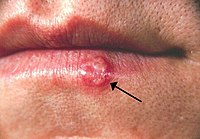
Photo from wikipedia
A nulliparous woman presented at 21 weeks’ gestation with a 72-h history of a rash on her left arm. Initially isolated to the forearm, it had quickly spread, becoming multiple… Click to show full abstract
A nulliparous woman presented at 21 weeks’ gestation with a 72-h history of a rash on her left arm. Initially isolated to the forearm, it had quickly spread, becoming multiple itchy fluid-filled blisters. Blood tests showed mild neutrophilia and raised CRP. Skin swabs demonstrated the presence of herpes simplex virus type 1 (HSV1) DNA. There was no history of previous HSV1 exposure. There is scant literature on uncomplicated cutaneous HSV1 since the majority is oral/genital. The incidence of transmission varies and is dependent on site of infection and immunological status. Type-specific serological testing is recommended to identify a primary first episode infection due to the 30–60% vertical transmission rate. Infection is associated with morbidity and mortality for both mother and fetus including maternal encephalitis, acute retinal necrosis, pneumonia and hepatitis. Neonatal disease can be congenital (cutaneous lesions, microcephaly, hydranencephaly, intracranial calcifications, chorioretinitis, microphthalmia and optic nerve atrophy) or acquired (skin, eyes and mouth disease or central nervous system disease or disseminated disease). Prophylactic aciclovir reduces the number of women with active genital lesions at the time of delivery. If primary infection occurs outside of the first trimester and active genital lesions are present, then vaginal delivery should be avoided. If infection has occurred in the first trimester, vaginal birth can be attempted even in the presence of active lesions. There is no available guidance on prophylactic treatment of non-genital HSV1 in pregnancy.
Journal Title: Obstetric Medicine
Year Published: 2017
Link to full text (if available)
Share on Social Media: Sign Up to like & get
recommendations!